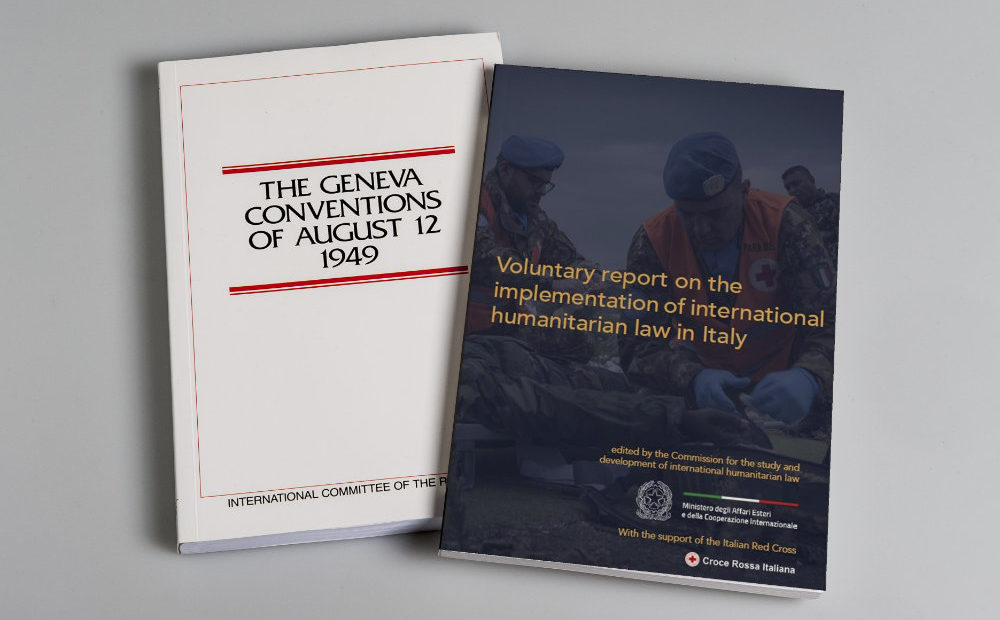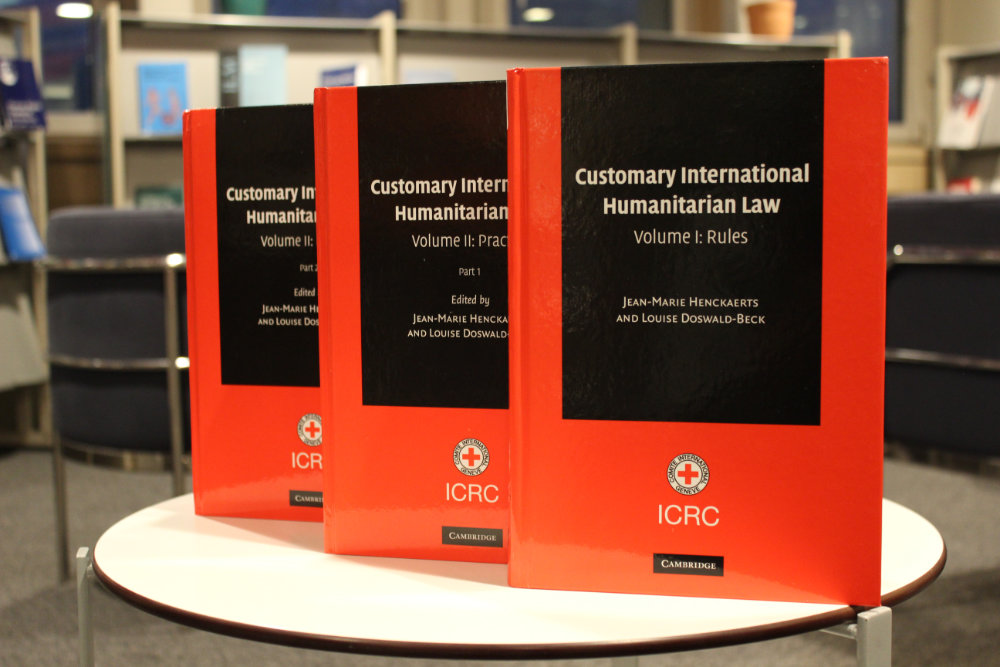The draft elements of the resolution ‘Toward a universal culture of compliance with international humanitarian law’ elaborated for the 34th International Conference of the Red Cross and Red Crescent ‘welcome the increasing number of voluntary reports published by states on the domestic implementation of international humanitarian law (IHL)’ (para. 13). This recognizes how voluntary reports are progressively implementing the recommendations made to states by the 2019 Resolution 1 ‘Bringing IHL Home’, ‘to carry out…an analysis of the areas requiring further domestic implementation…(and)…to share examples of and exchange good practices of national implementation measures taken in accordance with IHL obligations’.
In this post, and in the run-up to the 75th anniversary of the Geneva Conventions later this year, Giulio Bartolini, professor of international law and President of the IHL Scientific Committee of the Italian Red Cross, analyzes the genesis and characteristics of voluntary reports on IHL, underscoring their potential to play a role in favouring a ‘culture of compliance with IHL’.
In contrast to the international human rights treaty system, there is no mandatory reporting mechanism for states party to the main international humanitarian law treaties, namely the 1949 Geneva Conventions and their 1977 Additional Protocols. While reporting is not a novelty in IHL (as seen in Art. 26 of the 1954 Hague Convention or clauses in treaties on weapons systems, e.g. Art. 7 of the Cluster Munitions Convention), this lacune implies that IHL is partly at odds in comparison to other branches of international law where periodic reports on implementation measures are commonly present.
The absence of mandatory reporting in IHL could be explained both by the historical context in which the 1949 Geneva Conventions were adopted, a period in which such reports were uncommon, and by the lack of an institutionalized meeting of the States Party to the Geneva Conventions and Additional Protocols in charge of a periodic and comprehensive review of their application. Indeed, this role is not performed during the International Conferences, which are conversely engaged in gathering reports by states and National Red Cross and Red Crescent Societies on their implementations of resolutions and pledges. This system, however, suffers from some challenges, particularly its dependence on voluntary actions by involved entities and its lack of substantial review of submitted documents.
Nonetheless, attention has been progressively paid to the potential role of national reports and compatibility studies on the domestic implementation of IHL, namely, according to the ICRC’s definition, ‘any document drafted by or with the strong involvement of a state, often with the support of its national IHL committee and sometimes with the support of a National Red Cross or Red Crescent Society,’ with the purpose of setting out ‘to what extent international legal obligations have been incorporated into the domestic system (i.e. law, policy and practice) and to identify areas requiring action’. Some early examples were arranged by Germany (2002) and Poland (2008). Regarding compatibility studies reference could be made to the working documents on IHL issues periodically updated since 1997 by the Belgian National IHL Committee.
However, a shift could be recorded in recent times, particularly in relation to the proposal, tabled at the 32nd International Conference, to establish a regular ‘Meeting of States on IHL’. Based on a series of meetings of states, the Concluding Report (32IC/15/19.2) on Resolution 2 maintained how ‘states generally consider(ed) a reporting function to be an important tool for strengthening compliance with IHL’, even if it was also noted how during this process ‘questions discussed related primarily to the possible type of periodic reports and follow-up to them’.
Unfortunately, the overall proposal was finally not endorsed (here and here), but this initiative permitted to highlight the potential positive relevance of reporting on national compliance with IHL. This growing interest was confirmed in subsequent years, including through autonomous initiatives led solely by National Societies (2017, Danish Red Cross), and by mentoring activities in this area, such as the implementation report toolkit elaborated by the UK Government and the British Red Cross (2019).
Based on the recommendations included in the 2019 Resolution 1 to identify areas requiring domestic implementation and to share good practices, a series of states have recently engaged in drafting national reports on the domestic implementation of IHL, as exemplified by the United Kingdom (2019), Germany (2020), Switzerland (2020), Bulgaria (2021), Romania (2021), and Italy (2023), complemented by experiences in other continents through reports not made public (see here). This trend was also favoured by an open pledge to report on the domestic implementation of IHL submitted by some states and National Societies at the 33rd International Conference. This interest was confirmed during debates held in 2022 at the UN General Assembly’s Sixth Committee related to UNGA Resolution 77/107 on the status of the Additional Protocols to the Geneva Conventions, where the summary of positions highlighted how ‘several delegations also emphasized the usefulness of voluntary reports on the implementation of international humanitarian law at the national level and encouraged states to prepare and publish them’.
While the path appears promising, it would be opportune to focus on some structural characteristics of voluntary reports, based on a comparative assessment of existing documents, to highlight opportunities and challenges related to these initiatives. Regardless of potential different approaches on their drafting process and content, it is nonetheless possible to maintain how voluntary reports on the implementation of international humanitarian law fulfil two overarching purposes: first, they permit states to arrange a review of their domestic framework, by doing a comparison between obligations that bind them under IHL and how those obligations have been translated at the national level, potentially paving the way to further actions in case some shortcomings could be identified; and second, they might allow states to exchange among themselves good practices in different areas of domestic implementation, as well as on possible challenges.
Structure: a flexible approach
Concerning their structure, it could be mentioned how there is not a fixed model. Still, some supporting instruments could be identified as for the Model Compatibility Study included by the ICRC Advisory Service as Annex 3 to its 2019 Guidelines for National IHL Committees or the aforementioned IHL Implementation Report: Toolkit, which includes a structure template and practical suggestions on how to carry out such activities.
Generally speaking, reports typically provide a review on the implementation of IHL at the domestic level, with a specific focus on mapping ratification of IHL instruments, identifying domestic IHL stakeholders, explaining the role and activities of National IHL Committees and National Societies, and subsequently scrutinizing how involved states address distinctive topics, such as IHL military training and dissemination, protected persons and objects, including emblems, means and methods of warfare, and domestic repression of war crimes.
Even though reports commonly address key areas, nothing prevents states from tailoring such instruments to highlight specific elements of interest. For instance, the fourth periodic report arranged by Poland included a detailed analysis of IHL issues raised by Poland during its term at the UN Security Council, permitting it to externally highlight its contribution. Similarly, some reports have increasingly emphasized, as distinctive elements, domestic good practices to be shared with other states (Switzerland, Italy) through separate boxes or headings. This flexible solution might facilitate better sharing of experiences and, for governmental authorities, an increased chance to make their efforts more visible at the domestic and international levels.
The absence of fixed models is also reflected on their length and narrative style. Usually, such instruments are limited to few dozen pages elaborated in a plain language accessible to a public with some basic IHL background, as to be easily consulted even by non-legal experts such as politicians, members of the armed forces or university students. This choice is usually intentional, as highlighted by the Romanian delegate at the UNGA Sixth Committee, emphasizing how ‘the report is meant to give an overall picture of Romania’s actions in this area and further raise awareness about IHL in an accessible way to anyone interested in such matters, including the public’. On some occasions, conversely, particularly regarding compatibility studies, such instruments might have a more technical aspect, given their interest in identifying actions adopted or required, as highlighted by the fiches elaborated by Belgium.
Actors: different paths to state endorsement
Regarding the actors to be involved, the ICRC maintains that such documents should have official endorsement by state’s authorities and must imply their involvement. This is commonly achieved through their elaboration under the aegis of the national IHL committee led by governmental stakeholders, as was the case when national IHL committees drafted the reports of Bulgaria, Germany, Italy, Romania and Switzerland. This official character is also reflected in the final endorsement of these documents by senior officials from the Ministry of Foreign Affairs, as occurred with forewords written by the respective Ministers of Italy and Bulgaria.
However, on several occasions, a pivotal supporting role has been played by National Societies, as these entities have been in charge of drafting preliminary versions or supporting research activities, as exemplified by the role of National Societies in the drafting phases of the Bulgarian, Italian and UK reports.
Furthermore, multi-stakeholder consultations have commonly been carried out, as exemplified by credits to multiple actors in the Italian or Polish national reports. Such an array of actors could also be active in the drafting process, as exemplified by the Bulgarian report, which emphasizes how the national IHL committee worked with an expert working group charged with drafting the report, which ‘included a wide range of experts from government agencies, independent institutions, representatives of the academic sphere and the non-governmental sector; as well as other experts with expertise in the field of IHL’.
Final form: in public or on file
Commonly, states make such instruments publicly available, and furthermore, they have also been translated – in their entirety or to a large extent – into English (Bulgaria, Germany, Italy, Poland, Romania and Switzerland). This latter choice is commendable, as it permits a broader circulation of such instruments in view of potential exchange of experiences and good practices among states.
Needless to say, this solution is also a functional way for concerned states to promote themselves and make such reports fit for their humanitarian, legal and political international agendas. Nonetheless, there is no obligation to publish voluntary reports, as occurred for some reports not made public but on file with the ICRC Advisory Service.
The importance of follow-up
Once such documents have been adopted, a follow-up could be expected. First, we can already observe examples of periodic national reports, as highlighted by Germany (6 reports) or Poland (4 reports). This approach is a useful way to keep such instruments alive, as the domestic implementation of IHL is a constant process, permitting national authorities to continuously review the changing premises of the international and domestic legal order and, eventually, take into account the increasing sharing of external good practices to be reflected at the national level. In this regard, for instance, it could be helpful to include, in a potential open pledge on voluntary reports on the domestic implementation of IHL to be submitted to the 34th International Conference, a mention to the opportunity for states to periodically update them.
Second, some voluntary reports include sections devoted to recommendations on future actions to be realized at the domestic level. Such sections could be a natural outcome of the extensive review made and contacts held with relevant stakeholders, creating the background for identifying gaps and establishing the required trust for potentially accepting such suggestions. Still, there is not a uniform approach in national reports on this critical issue.
For instance, the Bulgarian report included recommendations separately proposed by the Ministry of Foreign Affairs, the National Society and academics, thus permitting actors to adopt different approaches to the extent of proposed recommendations. This possibility could be strengthened through the elaboration of a separate action plan, as occurred for Switzerland, whose 2020 voluntary report acted as a blueprint for the parallel action plan setting out further concrete measures to strengthen IHL. Still, voluntary reports might limit themselves to highlight the main areas where further actions could be helpful, leaving decisions on appropriate measures to the assessment of competent authorities. This has occurred, for instance, for the Italian report where the recommendation to update military manuals facilitated the recent decision by the Ministry of Defence to set up a working group for drafting a new IHL military manual.
Advantages and challenges in drafting voluntary reports
Drafting voluntary national IHL reports has its cons and pros. The elaboration of such instruments implies certain challenges, such as the need for a certain political commitment by relevant stakeholders, particularly governmental ones, and the necessity to carry out consultation processes with multiple actors and devote human (and eventually economic) resources to the drafting and editing phases. As fairly recognized by Switzerland in its 2023 report on the open pledge to report on the domestic implementation of IHL, ‘(r)egarding the challenges encountered, the preparation of a voluntary report required a certain amount of resources (human, financial, in time, etc.). Experts working on voluntary reporting have to do so while dealing with parallel challenging tasks’.
However, multiple benefits can be identified. Such instruments demonstrate tangible political interest paid by states toward IHL. At the domestic level, they represent an important self-assessment tool in supporting compliance with IHL and in identifying areas requiring better implementation. Furthermore, such initiatives can significantly strengthen the role of national IHL committees, paving the way for active cooperation among domestic stakeholders. Regarding their international dimension, such instruments are a useful way both to increase the political visibility of the state in this area and, in the absence of a mandatory reporting system on national implementation, are a helpful means to promote international cooperation through the exchange of good practices, further stimulating dialogue on IHL issues and its better implementation.
The specific reference to voluntary national reports and other means of reporting on domestic implementation in draft elements for the flagship IHL resolution at the next International Conference could serve as an opportunity to foster this trend and encourage other states to fully engage in this activity. This could facilitate more consolidated reflections on such experience and, eventually, pave the way for further supporting instruments and initiatives capable of taking stock from past practices.
Author’s note: Giulio Bartolini, along with Tommaso Natoli of the Italian Red Cross Society, was in charge of the scientific coordination, research and editorial activities related to the ‘Voluntary report on the implementation of international humanitarian law in Italy’. The views expressed in this blog are those of the author only.
See also:
- Jacob Coffelt, Codifying IHL before Lieber and Dunant: the 1820 treaty for the regularization of war, April 4, 2024
- Jonathan Kwik, Ai Kihara-Hunt, Kelisiana Thynne, From theology to technology: a call for IHL ambassadors in the Asia-Pacific region, March 28, 2024
- Yasmin Bedir, Omar Mekky, Towards national implementation of IHL: Arab states pledge their commitment, February 15, 2024






Comments